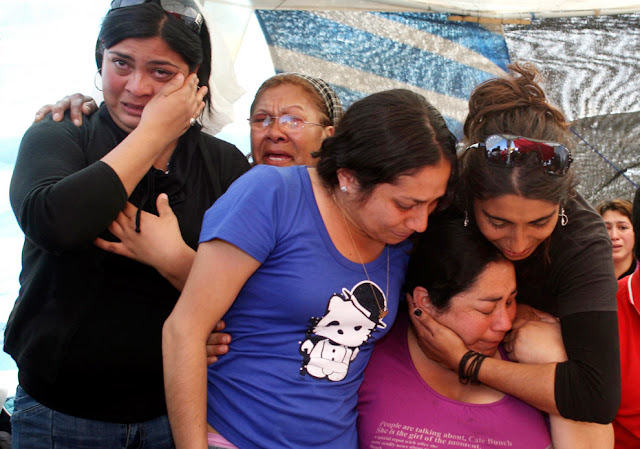Trapped in a Chilean mine
Over a month ago, on August 5, 2010, the roof of the San Jose copper and gold mine collapsed, trapping 33 miners inside, 700 meters (2,300 ft) below ground near Copiapo, Chile. The fate of the miners was not immediately known - it took 17 days before a drill reached their refuge, discovering them alive and well. Rescue work began immediately, but even with several concurrent plans underway, the quickest likely rescue will still take two to three months. Until then, the 33 men will have to endure high temperatures and humidity in isolated conditions. A video link has been established, many relatives have set up camp nearby, and food, air, messages and supplies are delivered by several narrow boreholes. Fluorescent lights with timers are to be sent down to attempt to keep the men on a normal schedule by imitating day and night as they care for each other and assist in their own rescue. Once it reaches them, the diameter of the rescue borehole will be very narrow. so each miner will have to ensure they have a waistline of no more than 90 cm (35 in) to escape.
Over a month ago, on August 5, 2010, the roof of the San Jose copper and gold mine collapsed, trapping 33 miners inside, 700 meters (2,300 ft) below ground near Copiapo, Chile. The fate of the miners was not immediately known - it took 17 days before a drill reached their refuge, discovering them alive and well. Rescue work began immediately, but even with several concurrent plans underway, the quickest likely rescue will still take two to three months. Until then, the 33 men will have to endure high temperatures and humidity in isolated conditions. A video link has been established, many relatives have set up camp nearby, and food, air, messages and supplies are delivered by several narrow boreholes. Fluorescent lights with timers are to be sent down to attempt to keep the men on a normal schedule by imitating day and night as they care for each other and assist in their own rescue. Once it reaches them, the diameter of the rescue borehole will be very narrow. so each miner will have to ensure they have a waistline of no more than 90 cm (35 in) to escape.
Relatives wait outside a collapsed mine where about 33 miners are trapped in Copiapo, Chile, Saturday, Aug. 14, 2010.
Rescue workers gather outside the San Jose mine where miners were trapped near Copiapo, northern Chile, Friday, Aug. 6, 2010.
View of the entrance of the San Esteban copper and gold mine, near the city of Copiapo, in the arid Atacama desert, 800 kilometers (480 miles) north of Santiago, on August 6, 2010.
Miner Daniel Espinoza waits outside a collapsed copper and gold mine to help in the rescue effort for 33 trapped miners in Copiapo, Chile, Saturday Aug. 7, 2010.
Relatives rest next to a copper and gold mine where 33 miners are trapped in Copiapo, Chile on August 6, 2010. Rescuers struggled on Friday to reach the miners trapped in the small mine in northern Chile after a cave-in a day earlier, hoping miners took refuge in an underground shelter with oxygen and water.
Relatives of trapped miners hold each other outside the San Esteban gold and copper mine on August 8, 2010.
A Chilean mounted policeman stands guard at the entrance of the San Esteban gold and copper mine on August 17, 2010.
Miners carry an effigy of Saint Lorenzo, patron saint of miners, before a mass outside a collapsed mine where about 33 miners are trapped in Copiapo, Chile on Tuesday, Aug. 10, 2010.
Chilean workers start a drilling machine outside the San Esteban gold and copper mine on August 17, 2010, trying to reach 33 trapped miners 12 days after the mine collapsed.
Relatives of trapped miners pray and light candles on an altar outside the San Esteban gold and copper mine on August 17, 2010.
Relatives of the miners trapped in the San Esteban gold and copper mine, stand by as the news comes that a probe has reached the place were they might be located on August 22, 2010. A drill probe seeking to determine whether 33 miners trapped for two weeks in a Chilean mine were still alive finally arrived at an emergency refuge where they might be, but no news of their situation has been released so far.
In this frame grab from TV channel 24 Horas, Chile's Mining Minister Laurence Golborne, left, smiles as an unidentified official listens to unknown sounds coming from the area of a collapsed mine where about 33 miners have been trapped for 17 days in Copiapo, Chile, Sunday, Aug. 22, 2010. The text at bottom reads in Spanish "Moment that it (a drill) reaches 688 meters. Miner indicates that 'knocking is heard'."
Chilean President Sebastian Pinera shows a message reading "We are fine in the refuge, the 33 of us", from the miners trapped in the San Esteban gold and copper mine on August 22, 2010. The miners are alive and contact was established with them 17 days after a structural collapse trapped them below ground.
Relatives of trapped miners react after learning that the 33 miners were found alive on August 22, 2010.
Chileans celebrate in the streets of Santiago after the confirmation of the survival of the 33 trapped miners on August 22, 2010.















0 comments:
Post a Comment